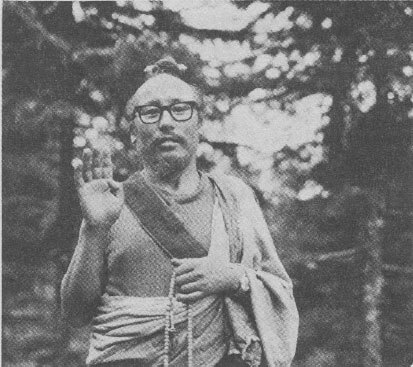| The following article is from the Autumn, 1993 issue of the Snow Lion Newsletter and is for historical reference only. You can see this in context of the original newsletter here. |
On July 23, 1993 Lama Yeshe jporje Rinpoche, the Dalai Lama's weather-controller, passed on. The folkwmg story was written by L.B. Grotte in memory of him.
A blue-black giant of a woman wearing a tigerskin loincloth, fifty feet tall with flaming orange hair, standing in a torrent of flames and holding a skullcup filled with blood. That was the sort ofperson we needed at the moment. Overcoming the monsoon requires almost unimaginable power. Before me, though, stands Yeshe Dorje Rinpoche, a gentle, bespectacled Tibetan lama. He also happens to be the primary weathercontroller for His Holiness the Fourteenth Dalai Lama of Tibet.

Glancing at the Rinpoche, it is hard to imagine that he can indeed marshal the necessary resources. This area has the second-largest annual rainfell in all of India. Yet he has a personal interest in altering today's weather. Construction at his monastery is to continue today, and the weather has to clear. But the weather is not obeying. It's still raining. Actually, it's pouring. Rinpoche is soaked, and so am I.
Quite sure we are the only human beings standing outside at 6:30 am in the rain, we are perched atop Zilnon Kagyeling Monastery in McLeod Ganj, roughly a mile up the hill from the palace of His Holiness. In afew days it will be His Holiness' birthday, and he has requested that Lama Yeshe Dorje ensure nice weather for the occasion. At 5:30 am I left a warm bed to climb up a muddy trail in the heaviest rain I have felt in my life, curious to see an indication of the Lama's ability.
It's looking bad for the Rinpoche. He seems unconcerned. Grinning at me through the downpour, he places a trumpet to his lips. No ordinary instrument, this; it is fashioned from a human thighbone. Used in practices to control the most powerful forces of nature, this kangling is covered in silver and leather. Rinpoche blows a long, plaintive note, followed by three shorter bursts. There is an enormous crack of thunder, and it seems to pour even harder My fancy Gortex raincoat is no more comfortable than a we towel. Even Rinpoche seems chastened. We watt. He sounds another series, which echoes into the mists and down to the valley floor.
However abstract the role of weather controller may seem to us in the West, it is a vital function for an agrarian society. In the high mountain fields of Tibet, the short growing season makes drought a constant concern. Damaging hailstorms or ill-timed rain, as well as too much bowls of wet concrete from person-to-person. A large project like this requires a lot ofvolunteer help, most ofwhom can only come on a Sunday.
Twenty minutes later, the rain is just as heavy. Rinpoche returns and I dutifully join him. Again, the thigh bone trumpet is brought out and blown. Smoke drifts into our faces from the juniper wood fire that is smoldering down below, ftriodkally, a special incense is thrown on the fire at Lama's direction, and its sweet pungency adds to the aroma of the juniper.
A figure appears through the mists. It is Tra-joong, one of the monks in three-year-retreat at the monastery. He brings an umbrella for Rinpoche, and I huddle with him under its slight protection.
A final series of notes and a series of mantras are whispered, and the Lama again smiles at me,blowing through pursed lips as he extends his right arm in a circle around himself. I understand that he's pantomiming pushing the clouds away. As he invites me down to breakfast, I note that the rain is finding its way right through the fabric of the umbrella. I feel a pang of sadness for the Lama. I would have wished him success this morning. He seems confidant, however, and his appetite demonstrates that he is unconcerned. In my honor, his son, Karma Sonam, has prepared French toast.
Carefully avoiding the subject of rain, I learn that the source of the Lama's power resides in his meditational practice, which originated in Tibet during the eighth century. At that time the tantric master Padmasambhava brought Buddhism to that country and started a lineage of practice known today as Nying-ma. A large gilded image of Guru Rinpoche, as he is known to the Tibetans, graces the temple at Zilnon Kagyeling.
Lama Yeshe Dorje is not only a Nying-ma Lama, but he is also a Ngag-pa, one of a small group of yogis who specialize in unusually difficult and dangerous practices requiring control of vast powers. One example is controlling the weather; another is the dm ceremony, in which the Lama summons all of the negative forces afflicting the people who come to the ritual, appeases and disperses them. The participants are thus relieved of the obstructing forces in their lives, whether physical or mental. So dangerous is this ritual that very few will perform it. Nonetheless, the Lama tells me later, it is much more difficult to control one's mind than to control the weather. He seems to be gently suggesting that the former is a more appropriate project for me than the latter.
We finish breakfast. It is still raining as the workmen appear and stand around helplessly. Rinpoche takes a nap. By 10 am the rain begins to stow, and it is only a light drizzle by 10:15. This is ideal, as the concrete will crack if it dries too quickly. I leave the monastery to visit the Library of Tibetan Works and Archives as Rinpoche begins to supervise the work from the roof of the monastery. When I return at about 2 pm, volunteers have arrived and are already passing concrete. I join them, struggling to keep up with Rene, a seemingly inexhaustible young girl who has become a student of the Rinpoche. By 6:30 the work is done. Clearly, the weather has been subjugated, after all.
Four days later, it is July 6th. His Holiness's birthday is celebrated by Tibetans through prayer ceremonies, feasting and singing. There is a slight drizzle at 6:30 am as I arrive at the monastery. Rinpoche confirms that he has already performed the ritual to ensure good weather, and that I should wait to see the result. True to prediction, it becomes a beautiful morning, and is clear and sunny almost all day.
The entire monastery is planning to have an outdoor feast for dinner, and I am invited. In the courtyard, Karma Sonam is overseeing a feast of meat, pancakes, and potatoes, and we are joined by a visiting lama and a Buddhist nun. Every dish is simple and delicious.
Clouds begin to roll in, but Rinpoche gives no hint of anxiety. Suddenly, a rainbow arcs over the monastery and the monks exclaim their delight. Rainbows are a special sign of Guru Rinpoche. I look to Lama Yeshe Dorje for his reactions, and am rewarded with a wink and a broad smile.
The monsoon continues the next day as usual.


